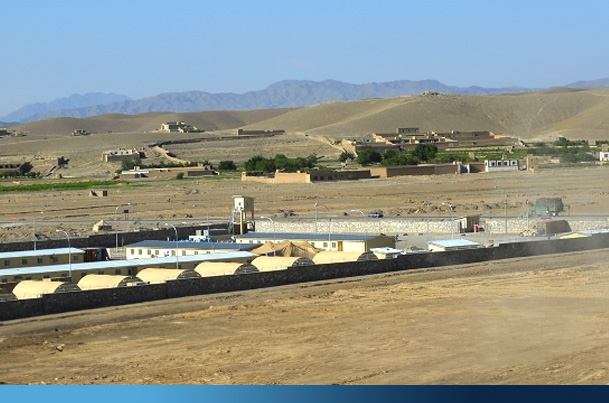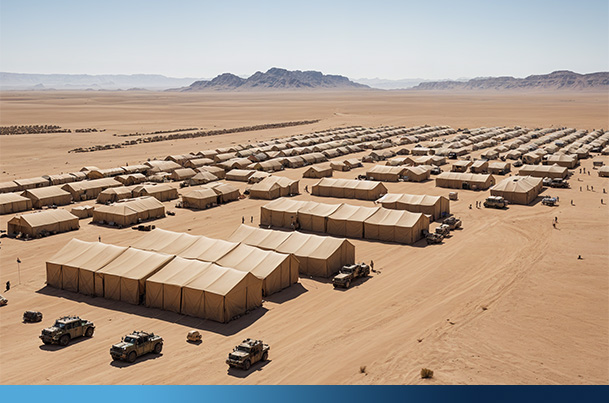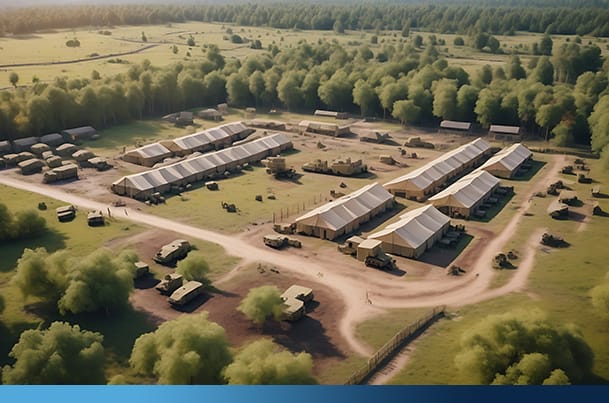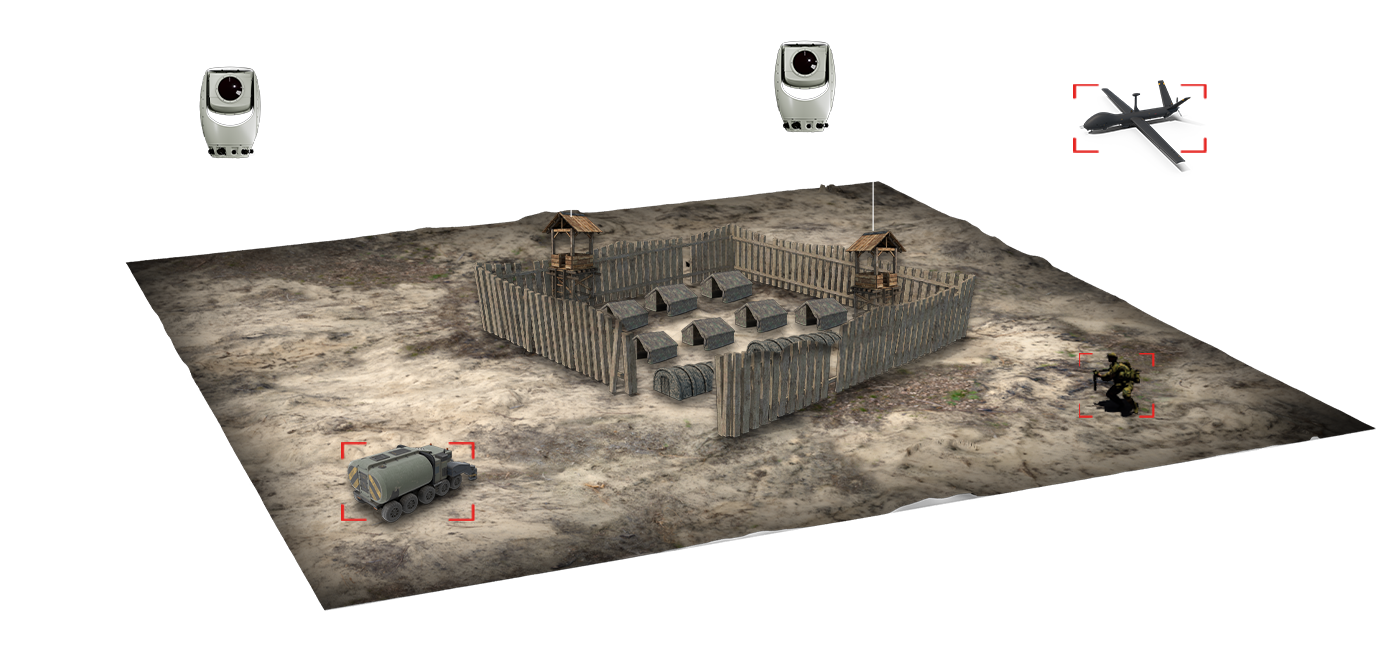Improve the surveillance of any Forward Operating Base (FOB)
Defense and Security forces often operate outside of developed areas and within isolated, high risk conditions. On these forward operating bases, 24/7 surveillance is not easily executed but is vital to mission success and personnel safety. Threats are unexpected and can come fromm all directions.
Forward Operating Base Surveillance: Main Challenges

24/7 Surveillance of Wide Areas
Forward Operating Bases (FOB) are typically located in remote regions, requiring continuous surveillance of extensive areas to monitor potential threats or intrusions around the clock. This constant vigilance is essential for maintaining security and readiness.
Need for Quick, Adaptive Deployment
Military bases are often established rapidly in response to evolving operational requirements. Surveillance systems must be adaptable and deployable on short notice to support mission-specific objectives.

Harsh Environmental Conditions
Forward operating bases can be situated in environments characterized by extreme weather conditions, including scorching heat, freezing cold, and heavy precipitation. Surveillance equipment must be rugged and weather-resistant to operate reliably under these challenging circumstances.
Potential for False Alarms Due to Cluttered Environment
The presence of natural elements, local wildlife, or civilian activity in the vicinity of military bases can lead to false alarms. Effective surveillance systems should employ advanced analytics and algorithms to minimize false alarms while maintaining high detection accuracy.

Operators with Insufficient Training
FOBs may have a rotating personnel roster, with operators who may not be seasoned surveillance experts. Surveillance systems should be user-friendly and require minimal training to ensure effective operation
Integration with C4ISR
Command, Control, Communications, Computers, Intelligence, Surveillance, and Reconnaissance (C4ISR) systems are vital for mission coordination and decision-making. Surveillance systems at forward bases should seamlessly integrate into the broader C4ISR network to provide real-time data and enhance operational effectiveness.
Forward Operating Base Surveillance: Main Threats
Extensive perimeter security, particularly in strategic operating environments, requires an advanced technological approach. Detecting, identifying and neutralizing threats before intrusion requires a combination of high technology, precision and rigorous data analysis. Advanced surveillance systems are at the heart of this proactive defense strategy.

Terrorist threats through terrestrial intrusions
Terrestrial intrusions represent perimeter violations by individuals, vehicles or animals. Surveillance systems need to be able to neutralize such threat before the intrusion. Main challenge for analysis of such threat at long distance would be to classify such threats as friend or foe at long distance.
Airborne threats
This mainly concerns drones (UAVs), helicopters or any other low-flying craft. Surveillance systems must be able to track flight paths, estimate altitudes and predict potential intentions. The use of trajectory analysis, combined with thermal analysis, makes it possible to detect flying objects even at variable altitudes and speeds, and to distinguish them from birds or other airborne objects.

Insurgent Activity
This encompasses a range of behaviors and activities, including suspicious reconnaissance, the assembly of hostile forces, or the movement of equipment. Surveillance must go beyond simple motion detection, incorporating behavioral analysis to identify unusual or suspicious patterns of activity. This involves a combination of pattern recognition, trajectory analysis and predictive modelling to assess risk in real time.
Sabotage
Sabotage can take many forms, including the manipulation or destruction of equipment, or the introduction of elements that can cause electromagnetic or system interference.
Forward Operating Base Surveillance
With Spynel Panoramic Infrared Cameras


HGH Infrared Systems has developed an innovative panoramic solution detecting and categorizing long-range threats. The SPYNEL infrared camera range protects any kind of critical infrastructures or military assets thanks to a 360° camera. Fully passive, the SPYNEL camera ensures real-time panoramic video and automatic detection, classification & tracking.
How to secure a Forward Operating Base Surveillance?

Why choosing Spynel for FOB?
Comprehensive 360-Degree Coverage
The SPYNEL Infrared Panoramic Camera provides unparalleled situational awareness with its 360-degree field of view. This expansive coverage eliminates blind spots, ensuring a comprehensive surveillance solution for Forward Operating Bases (FOBs) and allowing for early detection of potential threats from any direction.
Quick deployment & User-friendly GUI
In an environment where the surveillance missions can be diverse, this is important to have a system quickly deployable with a minimum of associated infrastructure. Within 15 minutes, SPYNEL panoramic surveillance system could be deployed.
With an user-friendly Graphic User Interface (GUI), any field operator, without technical background, is capable to use the system.
Multi-Target Detection and Classification
The SPYNEL thermal imaging technology enhances detection capabilities, allowing the classification of multiple targets simultaneously. This proves invaluable in identifying potential security threats, such as intruders or suspicious vehicles, regardless of ambient lighting conditions.
Adaptability to Harsh Environments:
Built to withstand challenging environmental conditions, the SPYNEL camera is resilient against factors such as extreme temperatures, humidity, and inclement weather. This robust construction ensures continuous and reliable operation in the unpredictable and often harsh conditions where FOBs are typically deployed.
Reduced False Alarms with Advanced Analytics
The integration of advanced analytics, with the use of deep-learning algorithms, minimizes false alarms by distinguishing between routine activities and potential security threats. This not only enhances the efficiency of surveillance personnel but also ensures that alerts are triggered only when significant anomalies are detected, reducing the likelihood of unnecessary responses.
Seamless Integration with FOB Security Systems
The SPYNEL camera seamlessly integrates with existing FOB security systems, providing a cohesive and interconnected surveillance solution. This interoperability enhances the overall efficiency of the security infrastructure, allowing for a unified response to potential threats and streamlining the overall surveillance strategy.









